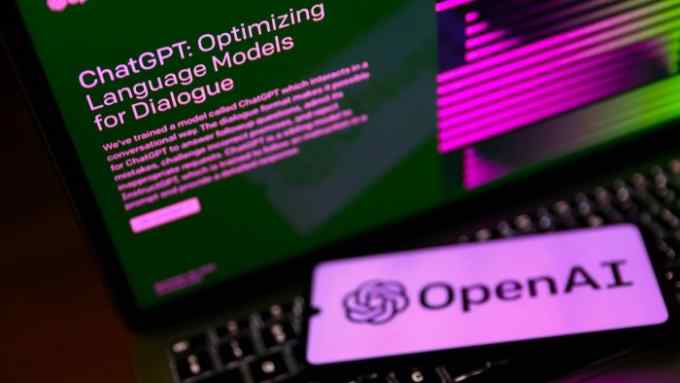Generative AI pioneers line up on legal tech

Roula Khalaf, Editor of the FT, selects her favourite stories in this weekly newsletter.
Suppliers of legal technology are focusing on the development of generative artificial intelligence products, as lawyers increasingly appreciate how these could change their working lives. Like their clients, legal-tech providers sense a high level of disruption is under way.
The would-be pioneers range from the Big Four professional services firms to information providers LexisNexis and Thomson Reuters, and to managed legal service providers and tech vendors.
“The timeline is now,” says Sandeep Agrawal, lead partner for the legal technology business at PwC UK. He reports an urgency among tech providers in vying to offer new generative AI tools to their lawyer clients — and in forming new partnerships in pursuit of that goal.
For example, PwC UK in March announced a deal with Harvey — a venture supported by a fund run by OpenAI, the Microsoft-backed start-up — to develop a generative AI platform for the legal sector.
Almost every facet of the legal services industry appears ripe for change, thanks to generative AI’s ability to search, synthesise, refashion, and represent information very fast — often within seconds.
Generative AI tools can be used for many laborious lawyerly tasks, such as comparing contracts for key clauses, which would fast-track negotiations, says Simon Harper, founder of managed legal-services company LOD.
Other uses of generative AI, he adds, include ensuring compliance with billing guidelines, or rewriting complex regulations in layperson vernacular. In 2021, LOD paired with legal tech consultancy Syke in order to jointly provide fuller advice and new tools to clients.
Developments such as these have the potential to transform longstanding legal concepts, such as: the traditional billable hour; dividing lines between the Big Four professional services firms and traditional law firms; managed legal service businesses that use lawyers in low-cost regions for lower-skill work; and aspects of regulatory schemes governing lawyers.
Generative AI platforms, or large language models, can accomplish so many tasks required by lawyers — researching legal precedents, drafting written arguments and contracts, or repetitive due diligence checks — that other people besides qualified lawyers could potentially more easily step into legal roles.
Generative AI raises “a big question from a regulatory perspective of who [and what] is permitted to practise law,” says David Wong, chief product officer for Thomson Reuters. His company is developing a “plug-in” to connect its own software applications with Microsoft’s 365 Copilot, a generative AI service.
The debate over lawyers’ roles is particularly urgent in the US, where ethics rules in most jurisdictions bar anyone but a licensed lawyer from being paid for drafting even a property-transfer form.
Now, courts in the US are starting to spell out explicitly how and when lawyers may use generative AI for submission. In June, a federal court in Northern Texas and the US Court of International Trade issued guidelines for lawyers’ use of AI-generated submissions — shortly after a New York lawyer’s citation of rulings fabricated by ChatGPT triggered headlines and sanctions.
Wong argues that further adoption will depend, at least partly, on further clarifications and amendments to current rules: “With the existing ambiguity [on the rules], it becomes very difficult to produce a product or to be able to offer something which can be then commercialised.”
But suppliers are not waiting for the regulators. “We [have] already started feeding in client-specific data to solve some client problems right now,” PwC’s Agrawal says — referring to PwC’s Harvey-based platform.
Initially, PwC focused on how generative AI could save time and increase efficiency around M&A. But it is also helping clients to prepare for compliance issues, draft documents, and analyse legacy contracts, he adds.
Agrawal says in-house counsel at multinational businesses have already invited PwC to join law-firm panels — their favoured, go-to suppliers of advice and services — for assignments that were previously only deemed achievable by top traditional law firms. He expects PwC’s share of some types of multinational transactions, such as M&A, to grow from 20 per cent to as much as 80 per cent once its new tools allow it to alter its pricing.
“We are currently working on a model where we don’t need to charge on billable hours,” Agrawal explains. “For most of the work, it will be on the basis of documents, or data, or output-based pricing.”
In May, KPMG in the US — where it is not authorised to practise law — and Microsoft unveiled a partnership to work on tools to develop virtual assistants for its tax-advice clients, as well as undertaking environmental, social and governance analysis. But KPMG entities outside the US — despite having some generative AI plans under way — remain reticent: “We are . . . not ready to talk externally about those and the matter in general,” said KPMG UK in June.
Many traditional law firms are also eager to develop generative AI solutions to meet the demand for speed and efficiency, observes Wong at Thomson Reuters. “We’re seeing interest and eagerness across the entire industry,” he notes.
In May, LexisNexis announced plans for a chatbot tool that leverages multiple large language models so users can conduct what it calls a “conversational search” of the company’s databases. The software automatically refines its answers, automates drafting, and summarises legal documents. “We’re building it organically, not with a partnership,” says Jamie Buckley, chief product officer at LexisNexis’s legal division. The company and “a small number of law firms” are testing a prototype, with a formal launch scheduled within months, he says.
Both Thomson Reuters and LexisNexis say their generative AI ambitions go no further than serving their existing client base of lawyers. “We’re basically building products to help our lawyers,” Buckley says. “We’re not going to practise law directly.” And he emphasises — as does Wong — that the new technology will make lawyers more efficient rather than obsolete.
Generative AI, however, does pose obsolescence risks for lawyers who take on outsourced and lower-skill legal work. “There will be a reshaping of managed service providers,” predicts Agrawal.
But LOD’s managed services unit — in part because of clients’ enthusiasm for the AI tools that its partner Syke is developing and on which LOD is consulting — has reported more than 50 per cent year-on-year growth in the past 12 months, says LOD’s Harper. That is higher than in any previous year.
Nor will generative AI replace the “senior partner walking along with you in the corridors” making the tough judgment calls during a multi-million-dollar deal or a messy courtroom battle, says Agrawal. “They will still command the premium,” he says, referring to rates that exceed $2,000 per hour. “That will never change, at least in the next five years, because clients will still want the degree of trust at that level.”

Comments